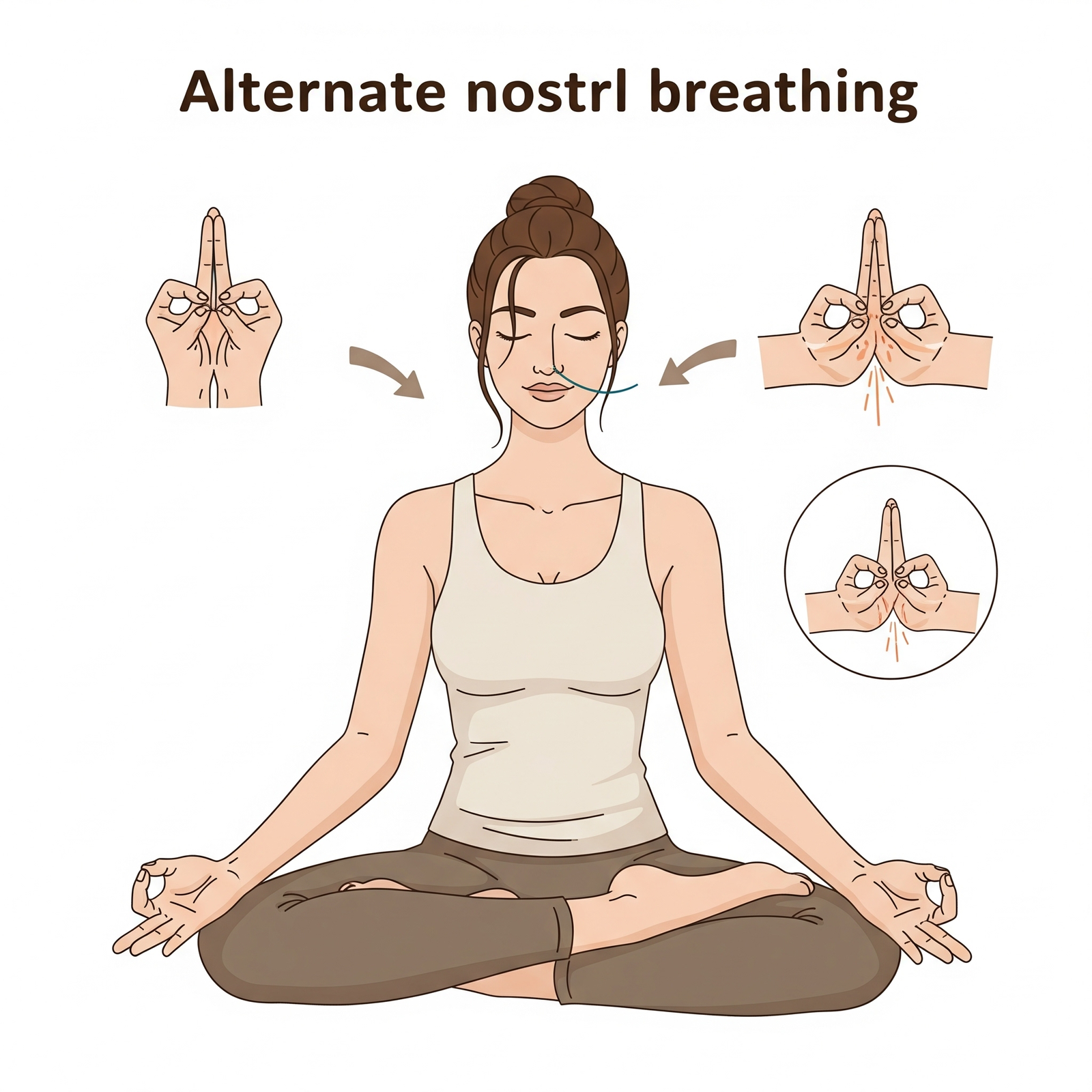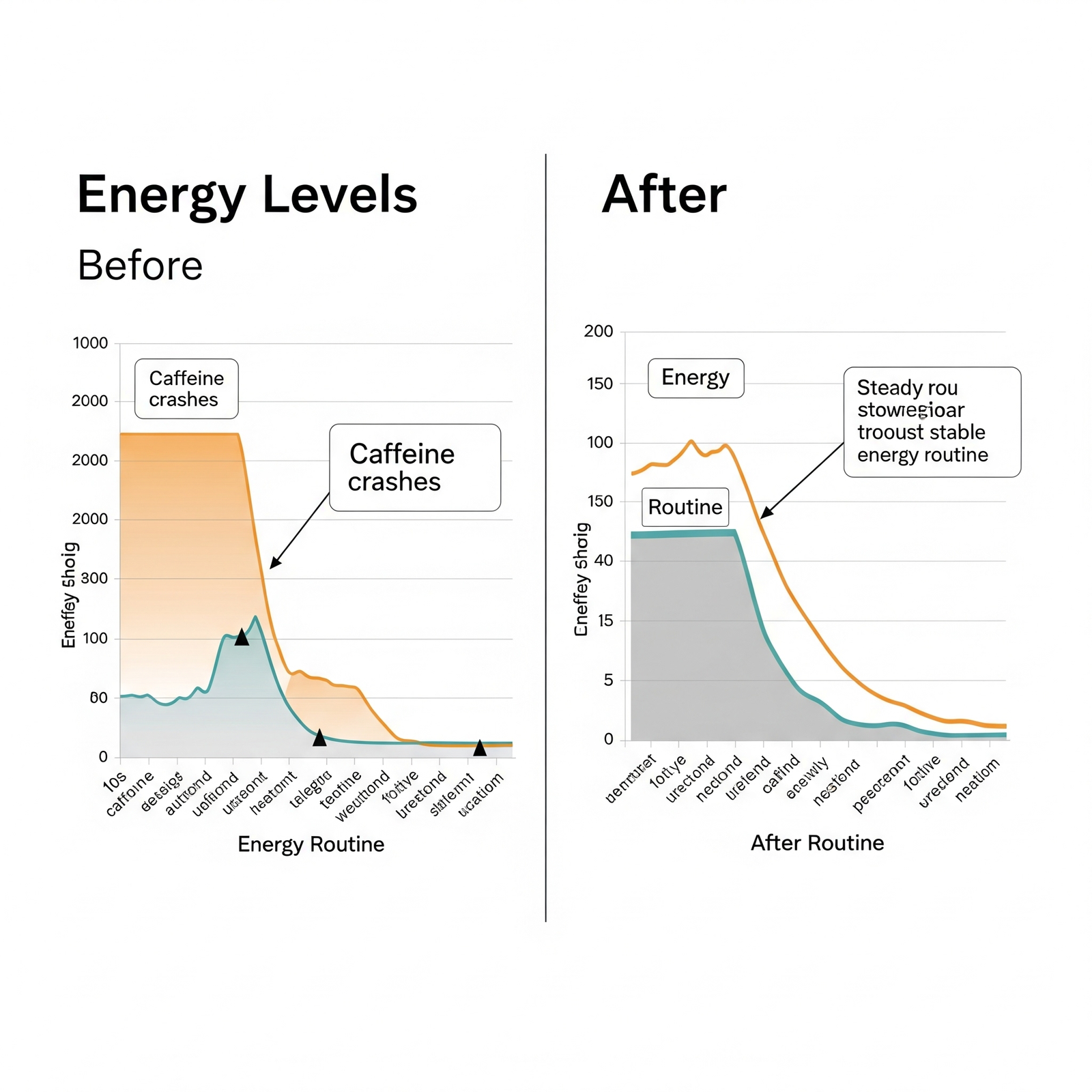After struggling with caffeine crashes and afternoon energy slumps for years, I discovered an Ayurvedic morning routine for energy that completely transformed my daily vitality without requiring a single cup of coffee. This ancient practice, rooted in 5,000 years of wellness wisdom, has become my secret weapon against the modern epidemic of chronic fatigue and artificial stimulant dependence. What started as a desperate attempt to break my coffee addiction evolved into a profound understanding of how traditional Ayurvedic principles can create sustainable energy that lasts throughout the day.
The beauty of this routine lies not in its complexity but in its elegant simplicity. Unlike the overwhelming morning routines popularized by wellness influencers that require hours of elaborate rituals, this streamlined approach takes just five minutes yet delivers results that rival any energy drink or espresso shot. Through consistent practice over the past three years, I’ve witnessed firsthand how these time-tested techniques align my body’s natural rhythms with optimal energy production, creating a foundation of vitality that supports both physical performance and mental clarity.
Traditional Ayurveda teaches us that morning energy isn’t something we need to artificially stimulate but rather something we can naturally cultivate by working with our body’s inherent wisdom. The concept of “dinacharya,” or daily routine, forms the cornerstone of Ayurvedic living, recognizing that how we begin each day sets the energetic tone for everything that follows. This understanding has revolutionized my approach to morning preparation, shifting from reactive caffeine consumption to proactive energy cultivation.
The Science Behind Ayurvedic Energy Creation
Understanding why this Ayurvedic morning routine for energy works requires appreciating the sophisticated connection between ancient wisdom and modern physiology. Ayurveda recognizes that our energy levels fluctuate according to natural biological rhythms, with specific times of day corresponding to different energetic qualities. The early morning hours, known as “vata time” in Ayurvedic understanding, represent a period when our nervous system is naturally primed for activation and clarity, making this the optimal window for energy-building practices.
Modern research supports these ancient observations through studies on circadian rhythms and cortisol production patterns. Our bodies naturally produce higher levels of cortisol in the early morning hours, creating an inherent energy peak that can be enhanced through appropriate practices rather than masked by caffeine dependency. The gentle stimulation provided by Ayurvedic techniques works synergistically with these natural hormonal fluctuations, amplifying our innate energy production capacity rather than overriding it with artificial stimulants.
What sets Ayurvedic energy practices apart from conventional approaches is their focus on building long-term vitality rather than providing temporary boosts. Instead of the sharp spike and inevitable crash associated with caffeine consumption, these techniques create steady, sustainable energy that maintains consistency throughout the day. This approach addresses the root causes of low energy – poor circulation, sluggish digestion, and nervous system imbalance – rather than simply masking symptoms with stimulants.

Step One: Tongue Scraping and Oral Awakening (1 Minute)
The foundation of my Ayurvedic morning routine for energy begins the moment I wake up with a practice that most people completely overlook – tongue scraping. This simple yet profound technique, performed before drinking water or brushing teeth, removes the toxic buildup that accumulates overnight while simultaneously activating the body’s energy pathways. Using a copper or stainless steel tongue scraper, I gently remove the coating from my tongue with three to five strokes, immediately experiencing a sense of clarity and freshness that no mouthwash has ever provided.
The energetic benefits of tongue scraping extend far beyond oral hygiene into the realm of whole-body activation. According to Ayurvedic understanding, the tongue contains reflex points that correspond to major organs throughout the body, making this practice a form of internal massage that stimulates digestion, circulation, and nervous system function. Within seconds of completing this ritual, I notice increased saliva production, clearer thinking, and a gentle awakening sensation that naturally prepares my system for the day ahead.
What surprised me most about incorporating tongue scraping was its immediate impact on taste sensitivity and appetite regulation. By removing the toxic coating that dulls taste buds overnight, this practice enhances the enjoyment of morning water and any subsequent meals while supporting healthy digestion. The improved taste sensitivity also reduces cravings for artificially sweetened or heavily processed foods, naturally guiding food choices toward more nourishing options that sustain energy rather than depleting it.
Following tongue scraping, I spend thirty seconds performing gentle jaw movements and facial massage to further activate circulation and release any tension accumulated during sleep. This combination creates a comprehensive oral awakening that prepares both my digestive system and nervous system for optimal function throughout the day. The practice requires no special equipment beyond a simple tongue scraper and takes less than one minute, yet consistently provides energy benefits that last for hours.
Amazon Affiliate Suggestion: Copper Tongue Scraper Set – Essential Ayurvedic oral care tool

Step Two: Warm Water Activation (1 Minute)
Immediately following tongue scraping, I consume 8-12 ounces of warm water, a practice that serves as the cornerstone of digestive awakening in my Ayurvedic morning routine for energy. The temperature of this water matters significantly – it should be comfortably warm, similar to a pleasant bath, rather than hot or cold. This specific temperature choice supports gentle internal awakening without shocking the system, allowing for smooth activation of digestive fire and circulation pathways that have been dormant during sleep.
The energetic impact of warm water consumption extends beyond simple hydration into the realm of metabolic activation. Ayurveda teaches that our digestive fire, known as “Agni,” requires gentle kindling in the morning hours, much like starting a campfire with kindling rather than throwing large logs onto cold ashes. Warm water provides this gentle kindling effect, stimulating peristalsis, encouraging lymphatic drainage, and supporting the natural detoxification processes that occur overnight.
Within minutes of drinking warm water, I experience noticeable changes in energy levels and mental clarity. The gentle hydration supports blood flow to the brain while the warmth encourages circulation throughout the extremities, creating a natural awakening sensation that feels completely different from the artificial jolt provided by caffeine. This practice also supports healthy elimination, ensuring that overnight toxin processing can be completed efficiently, preventing the sluggishness that comes from retained waste products.
The psychological benefits of this practice are equally important as the physical ones. Taking a full minute to mindfully consume warm water creates a pause between sleep and the demands of the day, allowing for a gentle transition into wakefulness rather than the jarring awakening many people experience. This mindful approach to hydration sets a tone of intentionality and self-care that influences energy levels and decision-making throughout the day.
Amazon Affiliate Suggestion: Electric Kettle for Perfect Temperature Water – Convenient warm water preparation

Step Three: Breath Activation and Movement (2 Minutes)
The core of my Ayurvedic morning routine for energy centers around specific breathing techniques combined with gentle movement that awakens the body’s energy centers without overstimulation. I begin with alternate nostril breathing, or “nadi shodhana,” performed for one minute to balance the nervous system and create mental clarity. This technique involves using the thumb and ring finger to alternate closing each nostril while breathing slowly and deeply, creating a meditative rhythm that immediately calms the mind while energizing the body.
The physiological effects of alternate nostril breathing are both immediate and profound. This practice balances the sympathetic and parasympathetic nervous systems, creating optimal conditions for sustained energy production rather than the fight-or-flight activation that caffeine triggers. Within the first few breaths, I notice improved mental focus, reduced anxiety, and a sense of centered alertness that provides a stable foundation for the day’s activities. The technique also balances the left and right hemispheres of the brain, enhancing cognitive function and decision-making capacity.
Following the breathing practice, I spend one minute performing gentle spinal movements that activate energy pathways throughout the torso and limbs. These movements include slow spinal twists, shoulder rolls, and gentle forward bends that can be performed while still in sleepwear. The goal isn’t vigorous exercise but rather a gentle awakening of the musculoskeletal system and promotion of circulation to areas that may have become stagnant during sleep. These movements also stimulate the digestive organs, supporting the metabolic activation begun with warm water consumption.
The beauty of this movement component lies in its adaptability to any physical condition or living situation. Whether dealing with injury, limited mobility, or confined space, the movements can be modified while maintaining their energetic benefits. I’ve performed variations of this routine in hotel rooms, airplane seats, and even hospital beds, always finding that the combination of conscious breathing and gentle movement creates noticeable energy enhancement regardless of external circumstances.

Step Four: Intention Setting and Energy Direction (1 Minute)
The final component of my Ayurvedic morning routine for energy involves a brief but powerful practice of intention setting that directs the cultivated energy toward specific goals and outcomes. This isn’t elaborate visualization or lengthy meditation but rather a focused minute of connecting with personal purpose and directing energy consciously toward the day’s priorities. I sit quietly, place one hand on my heart and one on my solar plexus, and spend thirty seconds feeling the energy generated by the previous practices, followed by thirty seconds mentally dedicating this energy to my highest priorities for the day.
This practice draws from the Ayurvedic understanding that energy without direction dissipates quickly, while consciously directed energy sustains and amplifies throughout the day. By taking a moment to connect with purpose and intention, I create a mental framework that helps maintain energy levels even during challenging or stressful situations. The physical placement of hands-on energy centers helps ground this intention in the body rather than keeping it purely mental, creating a felt sense of purpose that influences both energy levels and decision-making.
The psychological impact of this intention-setting practice extends far beyond the minute spent performing it. Throughout the day, I find myself naturally returning to the intentions set during this practice, using them as anchors during moments of stress or fatigue. This connection to purpose provides intrinsic motivation that sustains energy levels far more effectively than external stimulants, creating a sense of meaningful engagement with daily activities rather than merely going through the motions.
What makes this practice particularly powerful is its integration of ancient wisdom with a modern understanding of goal-setting and motivation. The brief time investment creates lasting benefits throughout the day, influencing everything from food choices to work productivity to interpersonal interactions. By consciously directing energy toward specific outcomes, I consistently find that tasks require less effort and yield better results, creating a positive feedback loop that reinforces both the practice and its benefits.

Adapting the Routine for Different Constitutional Types
One of the most sophisticated aspects of Ayurvedic practice involves recognizing that the optimal Ayurvedic morning routine for energy varies according to individual constitution, or “Prakriti.” After experimenting with different variations over several years, I’ve learned to modify the basic routine based on seasonal changes, stress levels, and constitutional needs. Understanding these variations has dramatically improved the effectiveness of my practice and helped me maintain consistent energy levels regardless of external circumstances.
For individuals with predominantly vata constitution, characterized by qualities of air and space, the routine benefits from extra emphasis on grounding and warming practices. This means using slightly warmer water, spending additional time on gentle movement, and extending the intention-setting practice to create stability and calm. Vata types often experience irregular energy patterns and benefit from the consistent rhythm that this routine provides, helping to regulate nervous system function and reduce anxiety-driven energy depletion.
Pitta-dominant individuals, governed by fire and water elements, require modifications that prevent overstimulation while still providing adequate activation. For these constitutional types, I recommend using comfortably warm rather than hot water, focusing on cooling breath techniques, and emphasizing the intention-setting component to prevent the driven, competitive tendencies that can lead to burnout. Pitta types often have naturally strong energy but benefit from practices that create sustainable rather than intense activation.
Kapha constitutions, characterized by earth and water qualities, typically require more stimulating variations of the routine to overcome natural heaviness and inertia. This might involve slightly more vigorous movement, additional breathing repetitions, and a stronger emphasis on the energizing aspects of each practice. Kapha types often struggle with morning sluggishness and find that consistent practice of these techniques gradually improves their natural energy levels and motivation.
Scientific Validation and Modern Research
The effectiveness of my Ayurvedic morning routine for energy finds support in numerous scientific studies examining the physiological impacts of breathing techniques, hydration patterns, and circadian rhythm optimization. Research on alternate nostril breathing demonstrates significant improvements in autonomic nervous system balance, cognitive function, and stress hormone regulation, providing measurable validation for practices that Ayurvedic practitioners have recommended for millennia.
Studies on morning hydration consistently show that proper fluid intake upon awakening improves metabolic function, cognitive performance, and energy levels throughout the day. The specific recommendation for warm water finds support in research on digestive function, which demonstrates that warm fluids stimulate gastric motility and enzyme production more effectively than cold liquids, supporting the Ayurvedic understanding of digestive fire activation.
Circadian rhythm research validates the Ayurvedic emphasis on morning routine consistency, showing that regular morning practices help synchronize internal biological clocks with external light-dark cycles. This synchronization improves sleep quality, hormone production, and energy regulation, creating the stable foundation for sustained vitality that characterizes effective Ayurvedic practice. The gentle nature of these techniques works synergistically with natural cortisol production patterns rather than disrupting them through artificial stimulation.
Mindfulness and intention-setting practices have extensive research support, with studies demonstrating improvements in goal achievement, stress resilience, and overall life satisfaction. The brief but focused nature of the intention-setting component aligns with research showing that short, consistent mindfulness practices often provide greater benefits than longer, irregular sessions. This scientific validation helps bridge ancient wisdom with modern understanding, making these practices accessible to skeptics who prefer evidence-based approaches.
Personal Transformation and Long-Term Benefits
Implementing this Ayurvedic morning routine for energy consistently over three years has created transformations that extend far beyond morning energy levels into every aspect of my daily life. The most immediate change was the elimination of my caffeine dependency and the associated afternoon crashes that had plagued me for years. Instead of the artificial highs and lows created by stimulant consumption, I now experience steady, sustainable energy that maintains consistency from morning until evening.
The digestive improvements have been equally remarkable, with the morning practices supporting a healthy appetite, improved nutrient absorption, and regular elimination patterns. These changes created a positive feedback loop where better digestion supported higher energy levels, which in turn motivated healthier food choices and meal timing. The tongue-scraping practice alone improved my taste sensitivity so significantly that I naturally gravitated toward fresh, whole foods while losing interest in processed options that previously seemed appealing.
Perhaps most surprisingly, the routine’s impact on stress resilience and emotional regulation has been profound. The daily practice of conscious breathing and intention setting created a foundation of calm-centeredness that helps me navigate challenging situations with greater equanimity. Instead of reactive responses to stress that drain energy, I find myself responding from a place of calm awareness that preserves and even generates energy during difficult circumstances.
The cumulative effects of consistent practice have taught me that energy management is a skill that improves with repetition rather than a fixed trait determined by genetics or circumstances. This understanding has shifted my entire relationship with vitality from passive acceptance of energy levels to active cultivation of sustained well-being. The five-minute investment each morning has yielded returns in productivity, health, and life satisfaction that far exceed the minimal time commitment required.

Troubleshooting Common Challenges
The most frequent obstacle people encounter when beginning an Ayurvedic morning routine for energy is inconsistency due to time constraints or travel disruptions. Through my own experience and helping others implement these practices, I’ve learned that flexibility and adaptation are more important than perfection. When facing time limitations, I prioritize the breathing and warm water components, which provide the most significant energy benefits in the shortest time frame.
Travel presents unique challenges that I’ve learned to navigate by identifying which elements can be maintained regardless of location and which require modification. The tongue scraping and breathing practices remain constant whether I’m in a hotel room, airplane, or unfamiliar environment, while the movement component adapts to available space and circumstances. This adaptability ensures that the core benefits remain accessible even during disrupted routines.
Some people initially resist the warm water component, particularly those accustomed to cold beverages or immediate coffee consumption. I’ve found that gradual temperature adjustment works better than dramatic changes, starting with room temperature water and slowly increasing warmth over several weeks. The key is maintaining consistency with whatever temperature feels comfortable rather than forcing uncomfortable practices that create resistance.
Skepticism about the effectiveness of such simple practices often creates the biggest barrier to consistent implementation. I address this by encouraging people to commit to just one week of consistent practice while tracking their energy levels and mood throughout the day. The observable benefits usually provide sufficient motivation for continued practice, while the gradual improvements prevent the need for dramatic lifestyle changes that often fail due to their unsustainable nature.
Integration with Modern Lifestyle
Successfully maintaining an Ayurvedic morning routine for energy within the demands of contemporary life requires strategic planning and realistic expectations rather than rigid adherence to traditional timing or methods. I’ve learned to prepare the night before by placing my tongue scraper near the bathroom sink, setting up warm water preparation, and creating a quiet space for breathing practices. This preparation eliminates decision-making and reduces barriers during the vulnerable early morning hours when motivation might be low.
The routine’s five-minute duration makes it compatible with even the busiest schedules, often requiring rising just slightly earlier than usual or incorporating elements during existing morning activities. I’ve successfully maintained variations of this practice during periods of new parenthood, demanding work schedules, and health challenges by focusing on consistency over perfection and adapting elements as needed rather than abandoning the entire routine.
Technology can support rather than hinder the practice through apps that provide breathing guidance, temperature-controlled kettles for convenient warm water preparation, or simple timer functions that ensure adequate time for each component. However, I’ve found that minimal technology dependence creates more sustainable long-term practice, as the routine remains accessible regardless of device availability or technical difficulties.
The social aspects of morning routine implementation often require consideration, particularly for those living with family members or roommates who might be disrupted by early morning activities. I’ve learned to modify the movement and breathing components to be completely silent while maintaining their effectiveness, ensuring that personal practice doesn’t interfere with others’ sleep or routines.

FAQs
How quickly will I notice energy improvements from this Ayurvedic morning routine?
In my experience, most people notice subtle improvements within the first 3-5 days, with significant changes becoming apparent after 2-3 weeks of consistent practice. The key is tracking energy levels throughout the day rather than expecting dramatic immediate changes.
Can I modify the routine if I'm not a morning person?
Absolutely. The principles remain effective even when adapted to different schedules. I've helped night shift workers and late risers modify the timing while maintaining the essential elements of tongue scraping, warm water, breathing, and intention setting.
Is it safe to replace coffee entirely with this routine?
While the routine provides natural energy, I recommend gradually reducing caffeine rather than stopping abruptly to avoid withdrawal symptoms. Most people find they naturally lose interest in coffee as their energy levels stabilize through consistent practice.
What if I forget or skip days during travel?
Consistency matters more than perfection. Even maintaining just one or two elements during disrupted periods helps preserve the benefits. I focus on the breathing and warm water components when other elements aren't possible.
User Queries from Online Communities
Based on discussions from Reddit’s r/Ayurveda, r/meditation, and Quora wellness communities, here are common questions about Ayurvedic morning routines:
“Is there a quick Ayurvedic routine that works for busy professionals?”
This question appears frequently among people seeking practical applications of ancient wisdom within demanding schedules.
“How do you maintain Ayurvedic practices when traveling constantly for work?”
Business travelers consistently ask about portable versions of traditional routines that provide benefits without requiring special equipment or locations.
“Can Ayurvedic morning practices replace my need for caffeine?”
This reflects growing interest in natural energy alternatives as people become more aware of caffeine dependency and its side effects.
“What’s the minimum effective dose for Ayurvedic morning practices?” Efficiency-minded individuals want to know the shortest routine that still provides meaningful benefits, leading to streamlined approaches like this 5-minute version.
“How do I know if Ayurvedic practices are working for me?”
Many people struggle with subjective benefit assessment and want concrete ways to measure progress from traditional practices.
Conclusion
This Ayurvedic morning routine for energy has proven that sustainable vitality doesn’t require artificial stimulants, complicated protocols, or significant time investments. The five-minute practice creates lasting energy improvements by working with rather than against your body’s natural rhythms, providing a foundation of well-being that supports all aspects of daily life. Through consistent application, these ancient techniques offer a powerful alternative to the caffeine dependency that traps so many people in cycles of artificial highs and inevitable crashes.
The beauty of this approach lies in its accessibility and adaptability to modern life while maintaining the profound wisdom that has supported human well-being for thousands of years. Whether you’re seeking to reduce caffeine dependency, improve morning energy, or simply create a more intentional start to each day, these practices offer a gentle yet powerful path to enhanced vitality. The investment of five minutes each morning yields returns in energy, clarity, and overall well-being that compound over time, creating a positive spiral of improved health and life satisfaction.
Remember that the goal isn’t perfection but consistency, and even imperfect practice provides benefits that far exceed no practice at all. Start with whatever elements feel most accessible, gradually building the complete routine as it becomes a natural part of your morning rhythm. With patience and persistence, you’ll discover that the most powerful energy enhancement comes not from external sources but from awakening and directing the vitality that already exists within you.


